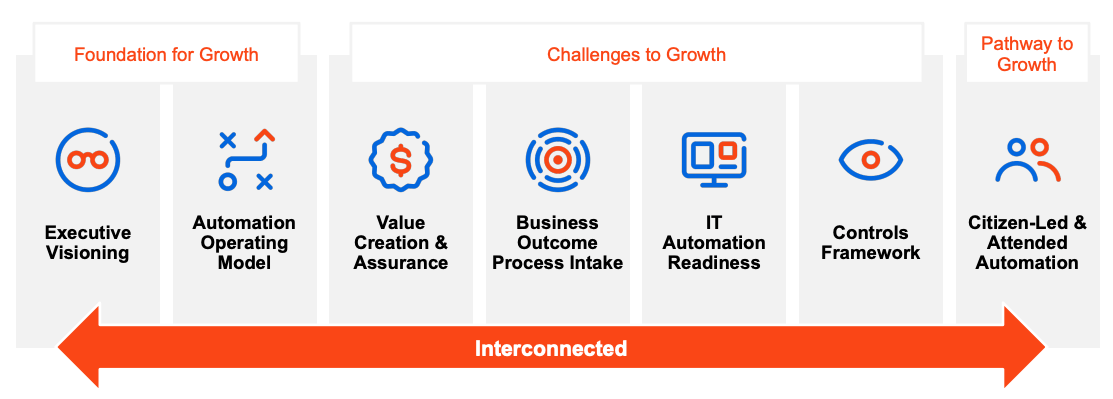Scale Your Automation Program with This 7-Pillar Framework
Share at:

The entire Robotic Process Automation (RPA) market faces broad, systemic challenges that can slow the scaling of automation.
According to Forrester, the RPA market will reach $2.9 billion by 2021. The rapid growth of RPA is happening alongside ecosystems that are becoming increasingly complex due to new technologies and harder to navigate thanks to new privacy regulations, legacy systems, and tighter budgets.
Organizations can’t overlook these challenges, and throwing technology at them won’t make them go away.
While a “how to scale your automation" playbook doesn't exist, we've created a framework you can use to guide your growth. Every company is different, but this framework provides the spine for your digital transformation journey.
The following seven-pillar framework is based on systemic problems many companies encounter, along with common strategies they have shared. The route you take, however—from developing a vision to becoming an ‘automation first’ organization—is unique to you.

Pillar 1: Executive visioning
When companies are moving from specific solutions with a handful of software robots to enterprise-scale, they often find the C-suite support they once had has dwindled.
There are barriers every organization will face before becoming automation first. Automation first is when your organization considers how robots can help before solving a problem or completing a process. Sustained executive support is the best way to break through the barriers that’ll emerge.
Sheer technological potential or prowess might dazzle, but it’s not enough to build trust.
Many organizations start with C-suite buy-in but fail to sustain it over time. Figuring out why it fades and how we bolster it requires a plan rooted in design thinking to create a holistic automation ecosystem—not just technology as a stand-alone solution.
Sheer technological potential or prowess might be enough to dazzle, but it’s not enough to build trust. Sustaining C-suite support requires developing and articulating a vision that executives can support every step of the way.
This vision has to emerge from the cross section between business objectives and technological possibilities. Organizations can only cross this gap with the art of the possible, which enables companies to prioritize progress over perfectionism.
Focusing on what we can accomplish today and tomorrow, not on a distant, abstract goal, is what makes this pillar foundational. RPA experts know that automation can serve business goals, but scaling requires demonstrating that reality to executives.
Help your C-suite drill down to the core problems that inspired current processes. Those problems, once articulated through the art of the possible, can drive new, transformational methods.
Guide executives through the impact they can have. Demonstrate what they need to do, where they need to rethink approaches, and where the technology can apply.
Pillar 2: Automation operating model
Fulfilling your vision requires an automation operating model that encompasses the entire business. The challenge of organization-wide transformation isn’t surmountable by a small team of RPA champions, even with executive support.
An automation operating model should include all the necessary stakeholders and potential dependencies. Building a robotic Center of Excellence (CoE) is a key component, but it’s only part of the automation operating model. This model operationalizes the support of RPA deployment, scaling, and transforming throughout the software development cycle.
This operating model includes several interlocking components:
The business where the targeted process exists
The CoE where the subject matter expertise resides
The IT team that takes robots into production
The internal audit team that monitors security and finances
The global risk and control team that guides the approval processes
The IT team, often overlooked for too long, is especially important to involve as early as possible. The internal audit teams will want visibility if you touch a financial process or encounter a data privacy issue. The global risk and control teams will want to weigh in on your goals and guide you through getting approval.
At the enterprise level, an executive-level steering committee is best for governing these parties and their concerns.
An automation operating model also accounts for the change-management procedures that will enable sustained transformation. As robots free capacity, you’ll need to be able to re-skill your workforce so they can pursue higher-value activities.
Recommended reading: Benefits of an Automation Operating Model (Part 1)
Pillar 3: Value creation & assurance
Return on investment (ROI) is foremost in everyone’s mind. No matter where you are in the journey, you have to regularly build business cases, justify investments, and track returns.
It’s relatively easy to demonstrate ROI with those early proofs of concept. Every business has a painfully slow, expensive process that robots can do better. Once you scale beyond these use cases, however, your values have to evolve.
Cost reduction is important but not sufficient.
You’ll most effectively progress by justifying investments based on value creation—not just cost reduction. This requires a holistic way of measuring the impact of automation via our third pillar: value creation and assurance.
Cost reduction is important but not sufficient. There are ways of measuring value that reach far beyond cost-cutting:
Revenue growth: RPA can grow revenues, not just decrease costs. For fast-growing businesses, the ability to grow revenues and build the company faster might be more compelling than cutting costs.
Customer experience: Automation can make it easier and more intuitive for customers to gain the value they seek from your business.
Employee experience: Automation can enable employees to get answers in near real time, so they can move on with their jobs and remain productive.
Compliance and regulatory issues: Automation can enable your organization to quickly adjust to new regulations as they emerge.
Demonstrating the value of RPA entirely through cost reduction is limiting. Measuring RPA by costs cut will make it look less effective if other business goals are a higher priority.
Pillar 4: Business outcome prioritization
Once you move past the low-hanging fruit of task automation, how do you tackle the 800-pound gorillas—the most complex processes with the greatest potential?
Though your proof of concept will likely generate immediate, significant ROI, the most significant impacts are going to come from your organization’s most complex processes. These successes, however, won’t be immediate. Your automation operating model needs an intake process that prioritizes business outcomes—our fourth pillar.
To scale, your automation operating model should have procedures for taking apart complex processes, tying tasks to business outcomes, and figuring out where robots can help.
The ability to make problems (and eventually solutions) out of complex processes is what separates an isolated deployment from a healthy pipeline.
The most effective process intake evaluates these complex processes end to end but starts at the very top level. Start by identifying the goal of all the work involved in the process, then look at the processes underneath those workflows. How can they improve? What can you automate, and how can you get the best value out of it?
Align your automation initiatives to strategic objectives by focusing on the workflows that support business outcomes. Identify your desired business outcome, work back to the processes and tasks that support it, and see where automation can help.
Pillar 5: IT automation readiness
When RPA first debuted, the problems it addressed resided mostly in the business, and salespeople primarily pitched business users. There’s nothing wrong with this starting point, but scaling requires IT support. The close involvement of your IT team is necessary for planning, building, and maintaining infrastructure as you scale across the enterprise.
You can only ensure integrity by involving IT early.
RPA deployment and scaling will stall if IT isn’t working in conjunction with business users.
IT is necessary for taking robots into production. Without them, your vision and your plans won’t get off the ground. Without them, you’ll be hoping instead of doing.
You can only ensure integrity by involving IT early. IT should be able to monitor robot deployments, provide disaster-recovery support, and ensure integration with the rest of the environment.
This pillar requires thinking from an IT perspective. A plan that lacks IT automation readiness will lead you to get stuck at the end of your development cycle. Without IT’s early involvement, you might have to wait months before you can get robots into production.
Get support from IT early on, and involve them regularly and deeply in the automation journey.
Pillar 6: Controls framework
Getting frozen right before production is one of the most common and most damaging traps a team trying to scale RPA can face. An unprepared IT team can stall production, but so can the lack of a controls framework—which is why we created pillar 6.
Even without explicit regulatory guidelines for automation, your automation operating model must be able to satisfy internal and external auditors. If you don’t involve internal audit- and risk-control teams early on, your deployment will again risk getting stuck.
Your controls environment depends on your industry and the effects of your business. It could involve the Sarbanes–Oxley Act, the General Data Protection Regulation, the Health Insurance Portability and Accountability Act, and more.
The key to success with this pillar is to apply a controls framework to process automation.
The industry-standard controls framework focuses on preventive monitoring. Map these requirements to the procedures you’re using to automate processes end to end. At the same time, remain conscious that automation will change the auditor role and make it more difficult to maintain the segregation of duties.
Pillar 7: Citizen model and attended strategy
After you’ve built an operating model, sustained executive sponsorship, learned how to intake processes, and justified financial investment, the next step for growth is to develop an attended robot strategy that leverages citizen developers.
Pillar 7 is your future: citizen developers that can identify opportunities big and small, and an attended robot strategy that can fulfill those requests effectively.
RPA might not seem to apply to certain processes at first, but the right mix of attended robots and human labor can transform a process for the better.
Attended robots can extend automation beyond the back-office and fill gaps that unattended robots miss.
Pillars 3 and 4 are important to establish before developing this pathway because you should already be in the mode of disentangling complex processes and creating value drivers. Once you operationalize these abilities and build in procedures for surmounting the challenges raised by the other pillars, the scope of transformation will widen.
RPA might not seem to apply to certain processes at first, but the right mix of attended robots and human labor can transform a process for the better. With attended automation, you can inject robots into complex, dynamic processes that involve varying amounts of creative human input and rote menial work.
Attended robots can, for instance, take over when a financial reporting process requires repetitive data entry; work in tandem with contact center agents gathering information to help a customer; or interface between human workers and unattended robots, passing tasks and results back and forth.
Creativity enables these use cases, but the need for creativity also limits them. A siloed RPA team is too far away from most processes to identify the tasks that most vex employees across the organization. Citizen developers are best suited to finding these gaps and enabling your organization to pursue the long tail of automation.
Whether citizen developers are leading the way or not, an attended strategy also needs a governance model. Governance ensures that these new robots still follow secure procedures and align with long-term strategies. Design governance procedures that give you control over the environment so you can ensure that your users get the right training and that no one breaks any systems of record.
Building toward your pathway for growth
These seven pillars are interconnected, but developing an executive vision and an automation operating model is foundational. Before you even start to scale RPA to a significant level, your team has to firmly establish these pillars.
The latter four pillars are ways to surmount the most common challenges to growth. These challenges can emerge at different points, varying across regions and industries, and you can best decide when to execute each of these strategies.
The last pillar is your pathway to growth. This is the lens through which you can think about doing bigger, creative things and enabling hundreds, if not thousands, of users via attended robots.
This framework is battle-tested. We’ve taken every one of these pillars into the market and implemented them, iterated them, and proven they work. Your journey is yours to make, but with this framework as your guide, you can grow faster, better, and more sustainably.
I presented on this topic at FORWARD III. You can get the recording and slides from my presentation and additional presentations straight to your inbox when you sign up for the free FORWARD III event pack.

VP, Automation Consulting, UiPath
Get articles from automation experts in your inbox
SubscribeGet articles from automation experts in your inbox
Sign up today and we'll email you the newest articles every week.
Thank you for subscribing!
Thank you for subscribing! Each week, we'll send the best automation blog posts straight to your inbox.



